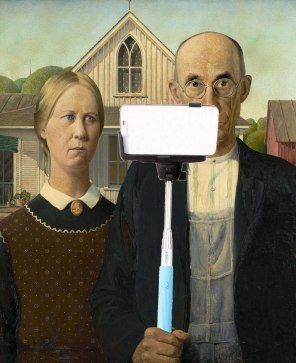Bored Selfies
i'm bored here's a selfie
-Ruby Brunton
The tilt of boredom spills
the tales of changes in
seasons. In heart.
A roaming hair ball
undoes the room
into a street from old Westerns.
Here you are, I in the mirror.
Here I am, blazing flashes
in my hand. I am so bored,
let's have a showdown.
Slow down, blown leaves.
Slow down.

"American Gothic" is one of the world's most familiar, iconic paintings, which has been lampooned and satirized countless times. It was first exhibited in 1930 at the Art Institute of Chicago (where it is still located) and garnered its creator a $300 prize. It was modeled after his sister Nan Wood Graham and a Cedar Rapids dentist, Byron McKeeby, standing in front of a house in the Gothic Revival style in Eldon, Iowa. Grant Wood was an active painter from an extremely young age, working in a large number of media, including lithography, ink, charcoal, ceramics, metal, wood and found objects. When he was 10 his father died and Wood became an apprentice in a local metal shop. After high school, he enrolled in The Handicraft Guild in Minneapolis, Minnesota, an art school run entirely by women (he may have returned there to paint "American Gothic"). After teaching for a while at a rural one-room schoolhouse, he enrolled at the School of the Art Institute of Chicago and also worked as a silversmith. Between 1922 and 1928, he made four trips to Europe, where he studied many styles of painting, especially Impressionism and Post-Impressionism. But he was most influenced by the 15th-century Flemish artist Jan van Eyck. From 1924 to 1935 he lived in the loft of a carriage house in Cedar Rapids, which he turned into his personal studio. In 1932 he was a co-founder of the Stone City Art Colony to help artists survive the Great Depression, and he lectured throughout the US as a proponent of regionalism in the arts; he also found teaching positions for his fellow Regionalists John Steuart Curry in Wisconsin and Thomas Hart Benton in Missouri, allowing them to return to their Midwest roots.
ReplyDeleteHe himself taught painting at the University of Iowa's School of Art from 1934 until his fatal illness in 1941, supervising mural painting projects, mentoring students, and becoming an active part of the school's cultural community. His talent provided him with a steady income, largely from mundane projects such as painting advertisements for local Iowa businesses, sketching the rooms of a funeral house for promotional flyers, and designing and, designing a corn-themed decor for the dining room of a hotel. In 1928 he traveled to Munich to supervise the the making of a stained glass windows he had designed for a Veterans Memorial Building in Cedar Rapids. During his military service, he was a camouflage painter. In 1940 he was one of nine artists hired to document and interpret dramatic scenes and characters during the production of the film version of Eugene O'Neill's "The Long Voyage Home." On February 12, 1942, one day before his 51st birthday, he died at the university hospital of pancreatic cancer. His estate went to his sister; when she died it passed to the Figge Art Museum in Davenport, Iowa.